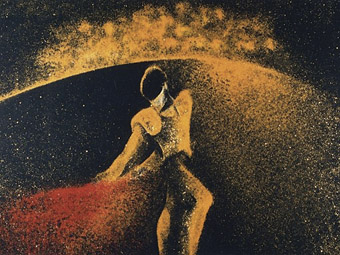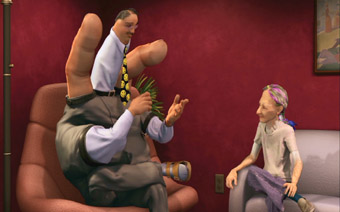tricks and treats
simon sellars: melbourne international animation festival

Carmen Torero
IN ITS 9TH ITERATION, THE MELBOURNE INTERNATIONAL ANIMATION FESTIVAL’S PROGRAMMING POLICY CONTINUES TO BE BRAVE AND ADVENTUROUS, AND THIS RESULTED IN ANOTHER DIVERSE SET OF PROGRAMS. THIS YEAR, THE BOAST WAS THAT MIAF SCREENED OVER 400 FILMS SELECTED FROM OVER 2,000 ENTRIES, SPREAD OVER 40 PROGRAMS AND REPRESENTING OVER 30 COUNTRIES. THAT’S A LOT TO ABSORB IN JUST SEVEN DAYS AND, AS ALWAYS, WHILE SOME SELECTIONS MAY BE A LITTLE UNDERWHELMING, THERE ARE ALWAYS UNRESERVED CLASSICS AT EVERY TURN. I MEAN THAT BOTH HISTORICALLY (MIAF TAKES GREAT CARE TO PRESENT AN OVERVIEW OF ACKNOWLEDGED GEMS FROM THE PAST) AS WELL AS INDULGENTLY: THERE ARE SO MANY MASTERPIECES BEING PRODUCED TODAY, AND MIAF, SEEMINGLY, GARNERS THEM ALL.
animating with sand
Each year, the festival spotlights a particular animation technique. In 2008, it was puppetry, which presented an excellent counterpoint to the industry’s surfeit of CGI. In 2009, it is sand animation, also promising. I was excited at the thought of a program dedicated to this laborious and visually stunning technique, which involves the manipulation of coloured powders (actual sand, most often, but also salt) over a light box, typically with hand brushes and air brushes. The program presented eight ‘classics’ and seven recent films, but the outcome was hit and miss. It seemed the form too often dictates the content because the technique necessarily involves swirling, dissolving imagery, generating too many twee scenarios (ponderous childhood reminiscing, dissolving memories) and a little too much navel-gazing, windswept hair and fluffy clouds.
A notable exception was Aleksandra Korejwo’s Carmen Torero (Poland, 1996; 3’45), based on Bizet’s Carmen. Korejwo’s skill is incredible, presenting a consistently mesmerising interpretation of Carmen’s interactions with the bullfighter, whose majestic cape-swinging movements through time and space engulf them both in great swathes of colour and grain (salt injected with dye in this instance, manipulated by animal feathers instead of brushes). Fur Mathilde (director Alla Churikova, Germany, 2009; 7’00) was also masterful, mixing a young girl’s (literally) black-and-white existence with her escape into the noise and colour of the city—some of the latter scenes are almost photorealistic, almost 3D, astonishing when you remember this is sand. But what I would really like to see in sand animation is a horror film. Imagine it, all that red powder and tenuous human forms —it would make for an excellent shower of blood, dissolving not into soft-focus memories but into traumatised brain tissue, skull fragments and exploded flesh. Just a thought…
internationals
There were 10 international programs: six mixed sessions plus tailored programs for digital forms, abstract films, long shorts and new Croatian animation. I enjoyed Bubblicious (Geoffroy De Crecy, France, 2008; 3’15), a film clip for Rex the Dog’s eponymous French house track, featuring a cut-out-style mutt rendered in 3D and singing the diva-like club anthem with serious attitude. Ridiculous, but infectious and super stylish. Two animations were distinguished by their hands-on technique. The Note (Hwang Bo Kumbyul South Korea, 2008; 3’30), about a letter that comes to life before the eyes of a child, is mesmerising, folding in on itself as ethereal bits of tracing paper prove to hold all sorts of secrets—morphing shapes, objects and scenarios barely held together by sticky tape…Almost like one of the family (Astrid Goransson, Sweden, 2008; 9’45) is bizarre and magical, with charcoal drawings on walls coming to life around a housewife in her kitchen, forming nested worlds within worlds that draw her deeper and farther away from the domestic.

The Spine
The Necktie (Jean-Francois Levesque, France, 2008; 12’15) is a wonderful tale of Kafkaesque bureaucracy that pits our puppet hero against an internecine office conspiracy involving people who are nothing more than (again, literally) paper cut-outs. It’s an instructive example of form underscoring a story, rather than dictating it. Chris Landreth’s The Spine (Canada, 2009; 11’00), voted Best of the Fest, is a breathtaking combination of sketch artistry impressed onto CGI frames in a style Landreth has dubbed “psycho-realism.” According to the filmmaker, CGI makes animators lazy, able to cheat and do ‘incredible’ tricks without thinking; psycho-realism, then, tricks the audience into thinking the scene is reality, until everything collapses into disturbing surrealism. In The Spine, characters are trapped in a marriage counselling session as strips of flesh hang from their faces, while the lead character, free from his domineering wife, grows an actual, literal spine when initially he was just a blob of a man. Landreth is working on an animated biopic of HP Lovecraft, a truly exciting prospect. Other international highlights were to be found in the London’s Calling program, a blend of advertisements and short films showcasing the best of that city’s animation, including Marc Craste’s Varmints (UK, 2008; 24’00), which is truly warped in its mix of elements: dystopian sci fi, apocalyptic alien invasion and, yes, cuddly animals. City Paradise (Gaelle Denis, UK, 2004; 6’00) is an outstanding live-action/animation tale of a Japanese girl who visits London only to find a city even stranger than she is. It’s a really smart inversion of the standard Lost in Translation-style ‘foreignness’ attributed to places like Japan.
australian panorama
With only a few misfires, the Australian Panorama was true blue. Factoids and Slapstick (Doug Bayne, 2008; 4’15) was part of the BigPond/Screen Australia–sponsored Great Moments in History competition, in which animators were invited to consider “funny stuff that happened between the Big Bang and the end of time.” Ostensibly, it tells the story of Vlad the Impaler, but the animator steps into the frame to express doubts about the whole storytelling process—clever and fun. The Aussie Panorama screened two other films in this series, but they weren’t as good, relying on tedious toilet humour. There should be an unimpeachable, ironclad rule in film school, along with those other immutable maxims they teach about good story: “NO FART/POO/BUM JOKES. Ever.”
Be Famous and Die (Simon O’Carrigan, 2008; 4’45) uses simple techniques to deliver a deeply felt monologue about the peculiarities of Melbourne’s obsession with statues of famous people. Laura Stitzel’s fabulous The Roaring Tide (2008; 4’00), drawn in Roaring 20s deco style (all blocky, angular shapes and zoot suits) is, joyously, about shipwrecked passengers who simply refuse to admit the severity of their situation, insisting instead on partying and unadulterated hedonism. Bronze Mirror (Susan Danta, 2008; 7’00), voted best Australian film of the festival, was a worthy contender. Based on a Korean folk tale, it uses surreal CGI to depict rural folk in old Korea mesmerised by a ‘demon’ they’ve never seen before—themselves in a humble mirror. But perhaps Mutt (Glen Hunwick, 2007; 7’00), about a dog in the outback obsessed with his ball even though he has no one to play fetch with him, should have got the nod. The technique (rounded, grossly caricatured characters), the set design and the colour scheme are outstanding, and the story is just too funny, the poor dog’s antics lingering in the memory. It was one of two great Aussie canine stories, the other being Dog with Electric Collar (Steve Baker, 2008; 4’45) which uses a whip-sharp style—pulsating, fantastical and colourful—to portray a dog who just can’t stop barking, even under threat of painful death.
All up, the MIAF team, led by Malcolm Turner, have really settled into a good groove, with a programming style that delivers. Our local animators have also risen to the challenge, proffering a brace of films that stand up to scrutiny. Here’s to the future.
2009 Melbourne International Animation Festival, ACMI Cinemas, Melbourne, June 22-28; www.miaf.net
RealTime issue #92 Aug-Sept 2009 pg. 31






